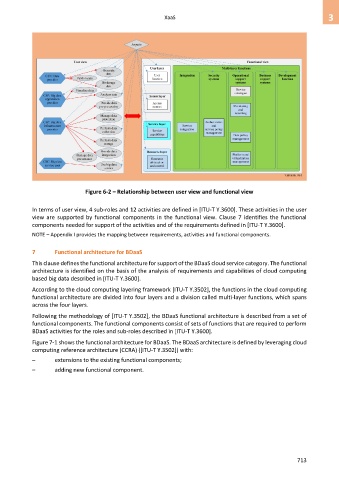Page 721 - Cloud computing: From paradigm to operation
P. 721
XaaS 3
Figure 6-2 – Relationship between user view and functional view
In terms of user view, 4 sub-roles and 12 activities are defined in [ITU-T Y.3600]. These activities in the user
view are supported by functional components in the functional view. Clause 7 identifies the functional
components needed for support of the activities and of the requirements defined in [ITU-T Y.3600].
NOTE – Appendix I provides the mapping between requirements, activities and functional components.
7 Functional architecture for BDaaS
This clause defines the functional architecture for support of the BDaaS cloud service category. The functional
architecture is identified on the basis of the analysis of requirements and capabilities of cloud computing
based big data described in [ITU-T Y.3600].
According to the cloud computing layering framework [ITU-T Y.3502], the functions in the cloud computing
functional architecture are divided into four layers and a division called multi-layer functions, which spans
across the four layers.
Following the methodology of [ITU-T Y.3502], the BDaaS functional architecture is described from a set of
functional components. The functional components consist of sets of functions that are required to perform
BDaaS activities for the roles and sub-roles described in [ITU-T Y.3600].
Figure 7-1 shows the functional architecture for BDaaS. The BDaaS architecture is defined by leveraging cloud
computing reference architecture (CCRA) ([ITU-T Y.3502]) with:
– extensions to the existing functional components;
– adding new functional component.
713

